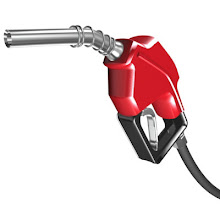
1. Avoid having to stop. If approaching a red light, see if you can slow down enough to avoid having to actually stop (because you reach the light after it is green). Speeding up from 5 or 10 miles per hour will be easier on the gas than starting from full stop.
2. Anticipate the stop signs and lights.Look far ahead; get to know your usual routes. You can let up on the gas earlier. Coasting to a stop will save the gasoline you would otherwise use maintaining your speed longer. If it just gets you to the end of a line of cars at a red light or a stop sign a few seconds later, it won't add any time to your trip.
3. Take off slowly from a full stop. This is one adjustment that will have dramatic effects on your gas mileage; don't tear off from a stoplight or stop sign! If you move out slowly, it will help save you money at the pump.
Also, if you are driving a stick shift, note that 50% throttle at 1200 rpm's uses less gas than 10% throttle at 2500 rpm's. As long as the engine is not lugging or pinging, shift as soon as possible and use plenty of throttle. The engine is more efficient when it does not have to pump air past a closed throttle plate. Warning: The last part of this advice is only true for fuel-injected cars or those with constant velocity carburetors.
4. Open roads? Maintain even speeds. Hills? Coast from the top, accelerate half way from the bottom to increase speed going up the other side. Curves? Look ahead and coast when you can to maintain safe speeds and speed up slowly coming out of a curve.
In general...Drive at a consistent speed. Avoid high acceleration and hard braking. Use cruise control when you can.
5. Slow down. Drive the speed limit. (this is hard, I know) Air resistance goes up as the square of velocity. The power consumed to overcome that air resistance goes up as the cube of the velocity. Rolling resistance is the dominant force below about 40 mph. Above that, every mph costs you mileage. Go as slow as traffic and your schedule will allow. Drive under 60-65 since air grows exponentially denser, in the aerodynamic sense, the faster we drive. To be precise, the most efficient speed is your car's minimum speed in it's highest gear, since this provides the best "speed per RPM" ratio.
6. Avoid idling. While idling, your car gets exactly 0 miles per gallon. Although starting the car used to use a lot of gas, it's now the same as idling for about 30 seconds. Idling to warm up is particularly bad, as the engine needs extra fuel to warm up. After start up, allow your car to idle 15-30 seconds, then drive conservatively until it reaches normal operating temperature. Park your car and go into the restaurant rather than idling in the drive-through. Idling with the air conditioning on also uses extra fuel.
Stopping and starting the engine frequently will cause extra wear. Don't stop the engine if you are going to idle for less than a minute.
In very cold environments, it is recommended to allow the vehicle to idle and warm up, rather than just start it and take off. You might save gas, but your engine oil won't do its job until it's fully liquid, so you'll spend more money on overhauls. That's where Bi-Tron shines. Rest assured that oil will be there every time you start your engine with Bi-Trons Engine Treatment!
5. Slow down. Drive the speed limit. (this is hard, I know) Air resistance goes up as the square of velocity. The power consumed to overcome that air resistance goes up as the cube of the velocity. Rolling resistance is the dominant force below about 40 mph. Above that, every mph costs you mileage. Go as slow as traffic and your schedule will allow. Drive under 60-65 since air grows exponentially denser, in the aerodynamic sense, the faster we drive. To be precise, the most efficient speed is your car's minimum speed in it's highest gear, since this provides the best "speed per RPM" ratio.
6. Avoid idling. While idling, your car gets exactly 0 miles per gallon. Although starting the car used to use a lot of gas, it's now the same as idling for about 30 seconds. Idling to warm up is particularly bad, as the engine needs extra fuel to warm up. After start up, allow your car to idle 15-30 seconds, then drive conservatively until it reaches normal operating temperature. Park your car and go into the restaurant rather than idling in the drive-through. Idling with the air conditioning on also uses extra fuel.
Stopping and starting the engine frequently will cause extra wear. Don't stop the engine if you are going to idle for less than a minute.
In very cold environments, it is recommended to allow the vehicle to idle and warm up, rather than just start it and take off. You might save gas, but your engine oil won't do its job until it's fully liquid, so you'll spend more money on overhauls. That's where Bi-Tron shines. Rest assured that oil will be there every time you start your engine with Bi-Trons Engine Treatment!




No comments:
Post a Comment